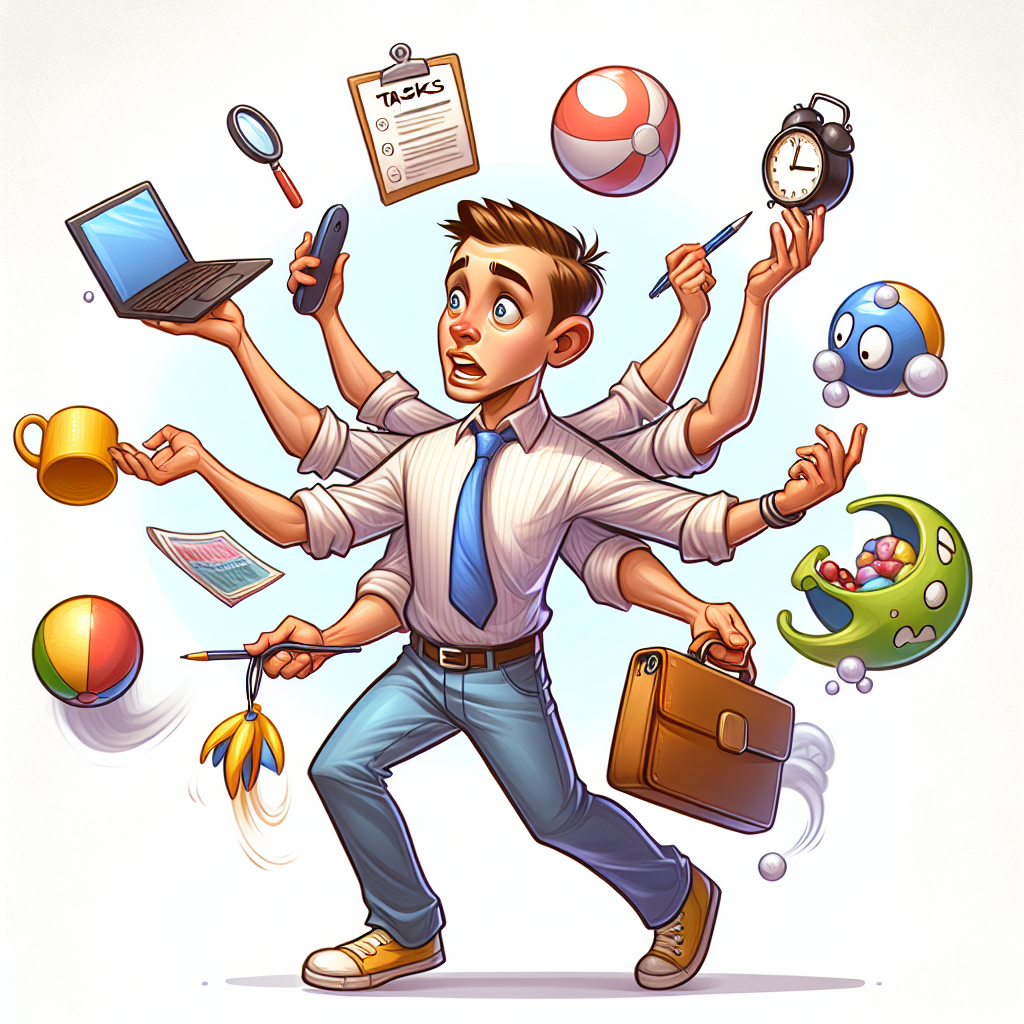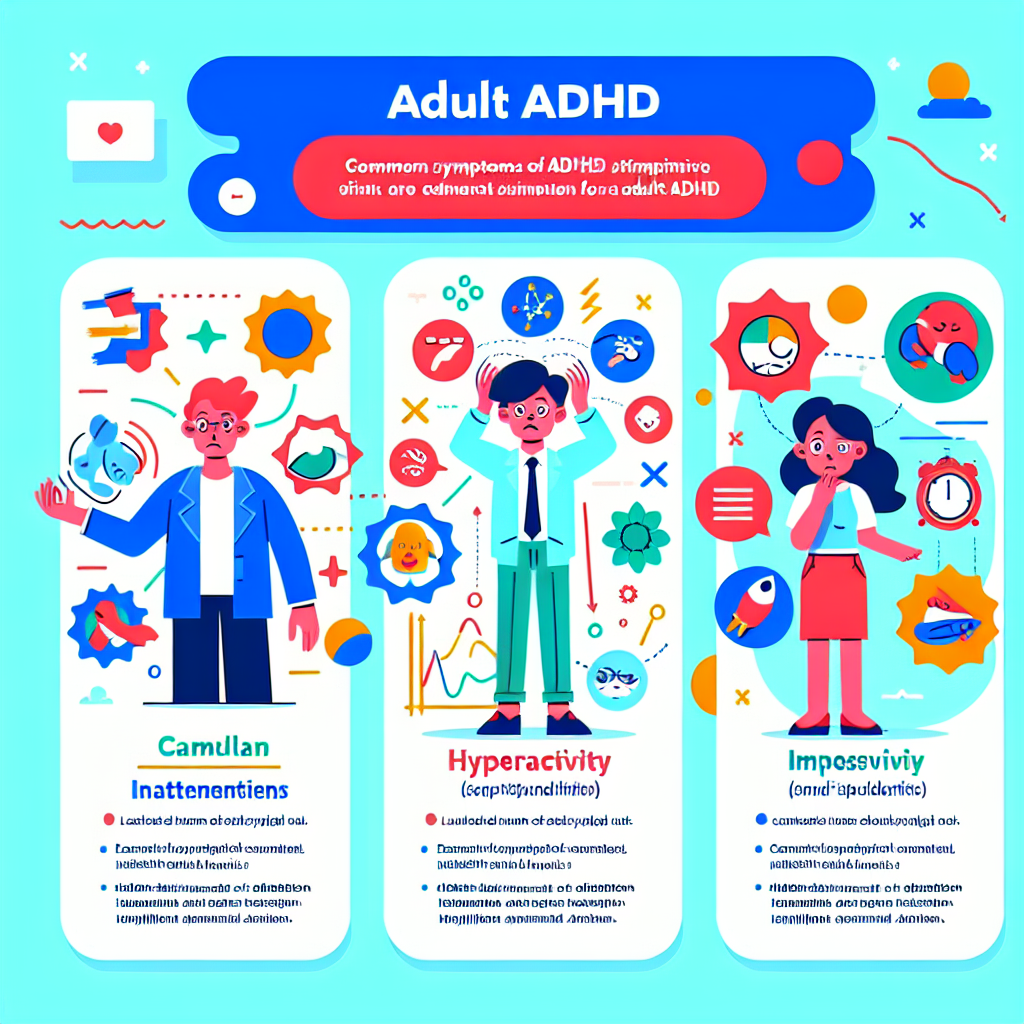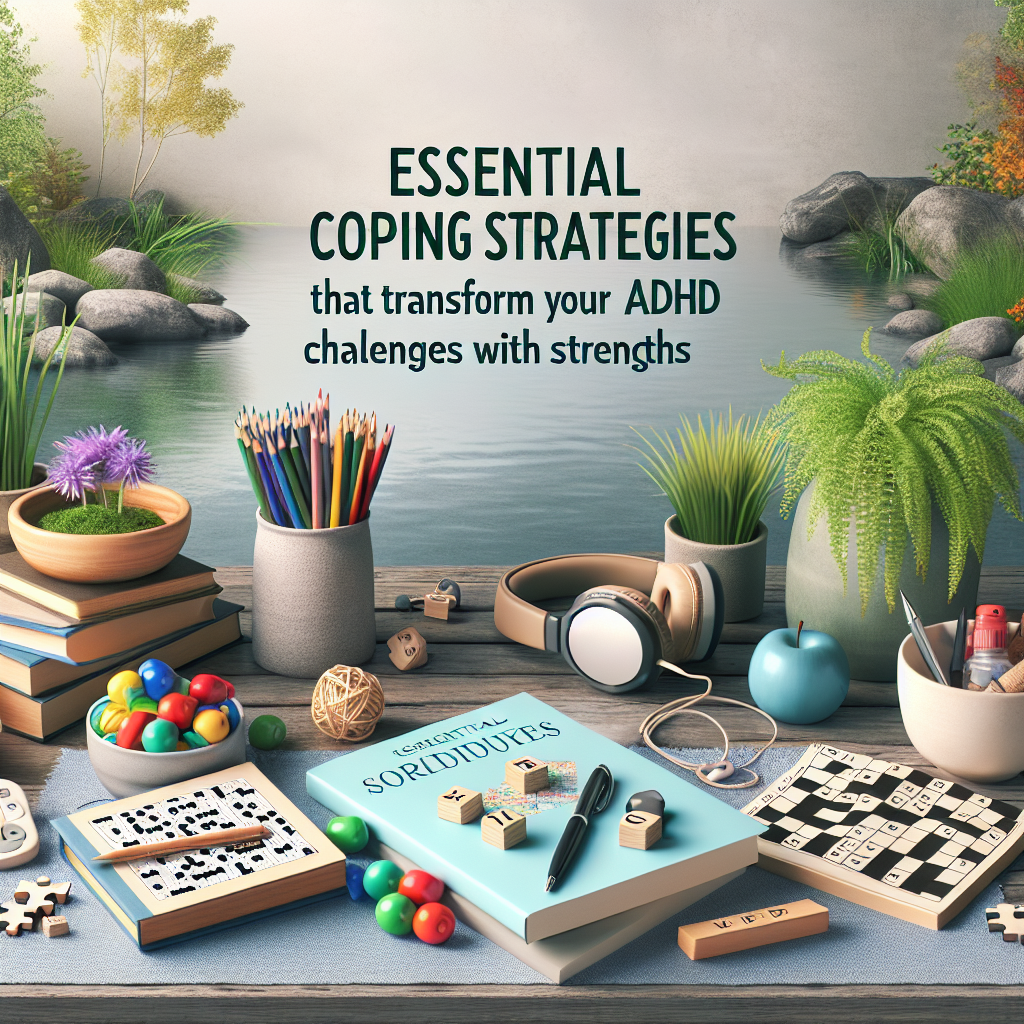
Hidden Signs: Recognizing ADHD Symptoms in Adult Life
Introduction
Welcome to the world of adulting, where bills are due, relationships are complicated, and sometimes you just can’t remember where you left your car keys again. Now, imagine trying to navigate this chaos while also dealing with the symptoms of having ADHD. Sounds like a wild ride, right? Well, buckle up because we’re about to dive into the hidden signs of ADHD that might be lurking in your everyday life.
ADHD doesn’t just vanish once you hit adulthood; in fact, many adults often find themselves grappling with symptoms that were overlooked or misdiagnosed during childhood. The signs of ADHD can manifest in a myriad of ways think focus problems, impulsive behavior, and organizational struggles that can turn even the simplest tasks into Herculean challenges.
So how do you know if you have ADHD? Recognizing these ADHD symptoms in adults is crucial not only for personal growth but also for improving relationships and enhancing overall quality of life. The journey begins with understanding what these symptoms look like and how they impact daily living.
According to the National Institute of Mental Health (NIMH), “ADHD is characterized by a persistent pattern of inattention and/or hyperactivity-impulsivity that interferes with functioning or development.”
In this blog post, we’ll explore everything from common ADHD symptoms to emotional dysregulation and even those pesky organizational problems that seem to follow us around like a shadow. By recognizing these signs early on, you can take proactive steps toward managing your ADHD symptoms effectively.

Understanding ADHD in Adults
So, what exactly is ADHD? Attention Deficit Hyperactivity Disorder, or ADHD, isn’t just a childhood condition that fades away like a bad haircut. It can stick around well into adulthood, often manifesting in ways that can make life feel like an obstacle course. Think of it as having a brain that operates on a different frequency one that’s constantly buzzing with distractions.
Definition of ADHD
ADHD is characterized by symptoms of inattention, hyperactivity, and impulsivity. While many people associate it with children bouncing off the walls, adult ADHD symptoms can be more subtle and often go unnoticed. You might find yourself daydreaming during meetings or losing your keys for the umpteenth time classic signs of having ADHD.
Common Misconceptions About Adult ADHD
One common misconception is that you outgrow ADHD. Spoiler alert: you don’t! Many adults live with undiagnosed conditions, leading to struggles at work, in relationships, and even during grocery shopping (yes, forgetting the list counts!). Another myth is that adults with ADHD are just lazy or unmotivated. In reality, they may be facing executive function issues that make organization and follow-through feel like climbing Everest without oxygen.
The Importance of Recognizing Symptoms in Adult Life
Recognizing the symptoms of having ADHD is crucial for adults to manage their lives effectively. Ignoring these signs can lead to chronic procrastination, time management problems with ADHD sufferers, and even social difficulties from having ADHD. By understanding these behaviors better like restlessness related to ADHD or emotional dysregulation in ADHD you can take proactive steps toward managing them.
Key Takeaway: Understanding adult ADHD isn’t just about identifying symptoms; it’s about empowering yourself to seek help and develop strategies for managing these challenges effectively.
Common Symptoms of Having ADHD
When it comes to the symptoms of having ADHD, it’s like trying to find Waldo in a sea of stripes sometimes the signs are subtle, and other times they practically wave a flag at you. Let’s break down the most common ADHD symptoms in adults, shall we?
Inattentive ADHD Symptoms
Picture this: you’re in a meeting, and your mind is wandering off to what you’ll have for lunch instead of focusing on the presentation. That’s a classic sign! Inattentive ADHD symptoms can include:
- Poor attention to detail
- Difficulty following through on tasks
- Frequent forgetfulness (like forgetting where you parked your car)
- Trouble organizing tasks and activities
Hyperactive ADHD Symptoms
If you’ve ever felt like a jack-in-the-box that just can’t stay down, you might be familiar with hyperactive ADHD symptoms. These can manifest as:
- Fidgeting or tapping hands/feet when seated
- Inability to stay seated in situations where it’s expected (like during a movie)
- Talking excessively (sorry, friends!)
- Feeling restless or on-the-go as if driven by a motor
Impulsive Behavior in ADHD
This one’s like being at an all-you-can-eat buffet but forgetting to check if you’re actually hungry first! Impulsive behavior can show up as:
- Saying something without thinking it through (oops!)
- Interrupting others during conversations
- Making hasty decisions without considering the consequences (hello, impulse buys!)
- Difficulties waiting for your turn in social situations
Takeaway: Recognizing these common ADHD symptoms is crucial for understanding how they impact daily life. If any of these resonate with you or someone you know, it may be time to explore further.

Recognizing Signs of ADHD in Daily Life
So, you suspect you might have ADHD or know someone who does? Welcome to the club! Recognizing the symptoms of having ADHD in daily life can sometimes feel like trying to find a needle in a haystack. But fear not! Here’s a handy guide to help you spot those sneaky signs of ADHD that may be hiding in plain sight.
Focus Problems with ADHD
Ever found yourself staring at your computer screen, only to realize that you’ve been daydreaming about what to have for dinner instead of actually working? Focus problems with ADHD can make it tough to stay on task. You might start strong but find your attention drifting faster than a cat chasing a laser pointer.
Concentration Issues with ADHD
This is like focus problems’ annoying sibling. While focus issues mean you’re struggling to stick with one task, concentration issues can make multitasking feel like juggling flaming torches while riding a unicycle. You may find it challenging to absorb information during meetings or lectures, leading to missed details that could come back to haunt you later.
Organizational Problems and ADHD
If your workspace looks like a tornado hit it, you might be experiencing some classic organizational problems associated with ADHD. From losing important documents (sorry tax forms) to forgetting appointments, these challenges can leave you feeling overwhelmed and frazzled. Keeping things tidy might seem simple, but for adults with ADHD, it can feel like trying to herd cats.
Time Management Problems with ADHD Sufferers
You know that feeling when you’re running late but somehow convinced yourself you have all the time in the world? Time management problems are common among those with ADHD. You might underestimate how long tasks will take or struggle with procrastination leading to last-minute panic and chaos. It’s like being late for your own surprise party!
Emotional and Behavioral Indicators of Adult ADHD
When it comes to the symptoms of having ADHD, emotional and behavioral indicators often take center stage. These signs can be subtle yet impactful, affecting everything from relationships to career success. Let’s dive into the emotional rollercoaster that many adults with ADHD experience.
Mood Swings and the ADHD Connection
Mood swings in adults with ADHD can feel like riding a rollercoaster without a seatbelt unexpected drops and climbs that leave you feeling dizzy. One minute you might feel on top of the world, and the next, you’re in a funk. This is largely due to emotional dysregulation, which is a common ADHD symptom in adults.
Emotional Dysregulation in ADHD
Emotional dysregulation refers to difficulty managing emotions effectively. For adults with ADHD, this can manifest as:
- Intense reactions to minor setbacks think spilling coffee leading to an existential crisis.
- A tendency to feel emotions more deeply than others, which can lead to social difficulties or misunderstandings.
Restlessness Related to ADHD
Ever felt like you’re a cat on a hot tin roof? That’s restlessness for many adults with ADHD! This constant urge to move or fidget can lead to:
- A need for constant stimulation whether it’s doodling during meetings or tapping your foot incessantly.
- Difficulties in situations requiring prolonged focus, such as long meetings or lectures.
- A sense of unease when sitting still, leading some individuals to pace or shift positions frequently.
Key Takeaway: Recognizing these emotional and behavioral indicators is crucial for understanding how ADHD affects daily life. If you relate to these experiences, it might be time to explore further whether these could be signs of adult ADHD.

The Impact of Childhood Experiences on Adult ADHD Symptoms
Ah, childhood the time when we all thought we’d be astronauts or rock stars! But for many, it’s also a period filled with the early signs of ADHD that can shape the adult we become. Understanding how childhood experiences influence the symptoms of having ADHD in adulthood is crucial in recognizing and managing these challenges.
First off, let’s talk about identifying signs of ADHD in kids. Often, children displaying inattentive ADHD symptoms, such as daydreaming or difficulty following instructions, are just seen as “a bit distracted.” However, these behaviors can be early indicators that something deeper is at play. If left unchecked, these childhood ADHD indicators can evolve into more complex challenges as adults.
Did you know? Research indicates that children with ADHD are at a higher risk for academic challenges linked to their symptoms? Understanding this connection can help us better support them!
Childhood Experiences and Their Relevance to Adults
The impact of childhood experiences on adult behavior patterns cannot be overstated. For instance, a child who struggles with hyperactivity and impulsivity might face social difficulties from having ADHD think of being the kid who can’t sit still during storytime or constantly interrupts during group activities.
These experiences often lead to feelings of inadequacy or frustration, which can manifest as emotional dysregulation in ADHD later in life. Adults may find themselves grappling with mood swings or restlessness related to their past experiences. Imagine trying to navigate adult responsibilities while battling procrastination due to ADHD it’s like trying to swim upstream with one arm tied behind your back!
A Closer Look at Executive Function Issues
Executive function issues in ADHD often stem from these formative years. Children who struggle with organization might grow into adults facing time management problems with ADHD sufferers. The inability to plan ahead or keep track of tasks can lead to significant stress and overwhelm.
- Focus Problems: Difficulty maintaining attention can lead to missed deadlines and forgotten appointments.
- Concentration Issues: These can affect work performance and relationships.
- Organizational Problems: A messy workspace often reflects a chaotic mind.
- Mood Swings: Fluctuating emotions may stem from unresolved childhood experiences.
If you’re wondering how to know if you have ADHD as an adult, reflecting on your childhood might provide some clues. Did you have concentration issues with ADHD back then? Were you labeled “the daydreamer” or “the troublemaker”? Recognizing these patterns may help you understand your current struggles better.
The journey from childhood through adulthood is complex, especially when navigating the symptoms of having ADHD. By understanding how early experiences shape our behaviors today, we can take proactive steps toward managing our symptoms effectively.
The Challenges Faced by Adults with Undiagnosed or Untreated ADHD
Living with undiagnosed or untreated ADHD can feel like navigating a maze blindfolded. You know there’s a way out, but every turn leads to another dead end. Many adults struggle silently with the symptoms of having ADHD, often unaware that their daily challenges stem from this condition.
Let’s dive into some of the most common hurdles faced by these individuals:
- Focus Problems: Imagine trying to watch your favorite movie while someone constantly changes the channel. That’s what it feels like for many adults dealing with focus problems with ADHD. Everyday tasks become monumental challenges, leading to frustration and fatigue.
- Time Management Issues: Picture this: you have a deadline looming, but instead of working on it, you find yourself scrolling through social media or binge-watching that new series. This is a classic example of how time management problems can derail productivity for those with ADHD.
- Emotional Rollercoaster: Mood swings and emotional dysregulation in ADHD can make life feel like an emotional tug-of-war. One moment you’re on top of the world; the next, you’re spiraling down into frustration or sadness. It’s exhausting!
- Social Difficulties: For many adults with untreated ADHD, social interactions can be tricky. Misreading social cues and impulsive behavior in social settings can lead to awkward situations and strained relationships.
- Academic and Career Challenges: Whether it’s forgetting assignments or struggling to stay organized, academic challenges linked to ADHD often carry over into adult life. Many find themselves underperforming at work due to these persistent issues.
- Sensory Overload: Think about the last time you were in a crowded place loud noises, bright lights, people everywhere. For someone with ADHD, sensory overload can be overwhelming and lead to anxiety or irritability.
Did you know? According to recent studies, adults with untreated ADHD are at a higher risk for anxiety disorders and depression. Recognizing these signs early on can pave the way for effective management strategies!
The journey towards understanding one’s own brain can be daunting, but recognizing these challenges is the first step toward seeking help. If any of this resonates with you or someone you know, it might be worth exploring further because living without answers is no fun at all!

Managing and Coping with Adult ADHD Symptoms
So, you’ve recognized some symptoms of having ADHD in your adult life now what? Managing those pesky symptoms can feel like trying to herd cats, but with the right strategies, it’s totally doable. Let’s dive into some practical tips and tricks that can help you navigate the challenges associated with ADHD symptoms in adults.
Strategies for Managing Symptoms
- Break Tasks into Smaller Steps: Instead of tackling a project all at once, break it down into bite-sized pieces. Think of it like eating a pizza; you wouldn’t try to shove the whole thing in your mouth at once slice by slice is the way to go!
- Create Routines: Establishing a daily routine can help anchor your day. Consistency is key! Try setting specific times for tasks, much like a TV schedule except way less entertaining.
- Use Visual Aids: Sticky notes, planners, or digital reminders can be lifesavers. They serve as friendly nudges to keep you on track and minimize those forgetfulness as a symptom of ADHD moments.
- Pace Yourself: It’s easy to get overwhelmed by everything at once. Practice taking breaks and pacing yourself through tasks. Think of it as running a marathon instead of a sprint slow and steady wins the race!
- Limit Distractions: Create an environment conducive to focus. This might mean decluttering your workspace or using noise-canceling headphones if you’re prone to sensory overload issues.
Seeking Professional Help: Diagnosing ADHD
If you suspect that your struggles are more than just typical adulting woes, seeking professional help is crucial. A qualified mental health professional can assist in diagnosing ADHD accurately and provide tailored treatment options. Think of them as your personal guide through the labyrinth of attention deficit hyperactivity disorder symptoms.
Tangible Takeaway: Don’t hesitate to reach out for support! Whether it’s therapy or medication, professional guidance can make all the difference in managing ADHD symptoms effectively.
Coping with adult ADHD isn’t about fighting against it; it’s about understanding how it affects you personally and finding ways to work with it. With these strategies in your toolkit, you’re well on your way to mastering those symptoms of having ADHD!
- Strategies for Managing Symptoms < li >Seeking Professional Help: Diagnosing ADHD
Conclusion
< / section >


